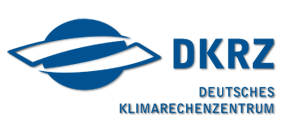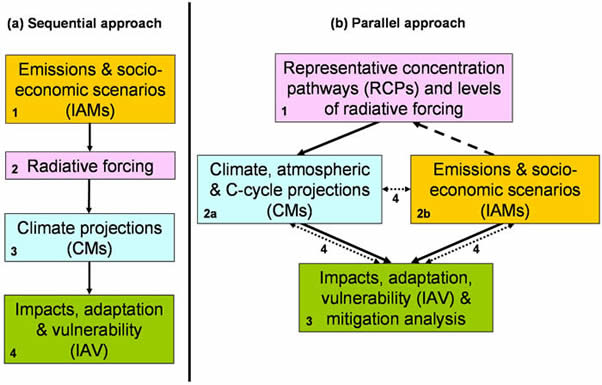SCENARIO PROCESS FOR AR5
SCENARIO PROCESS OVERVIEW
New sets of scenarios for climate change research are needed periodically to take into account scientific advances in understanding of the climate system as well as to incorporate updated data on recent historical emissions, climate change mitigation, and impacts, adaptation, and vulnerability.
Sequential process
Previous scenario exercises in the climate change research
community were developed and applied sequentially in a linear causal
chain that extended from the socioeconomic factors that influence
greenhouse gas emissions to atmospheric and climate processes to impacts
(see “Sequential approach” in panel a of Figure 1, below). Detailed
socioeconomic scenarios were developed first and used to prepare
emissions scenarios, which in turn were used in climate model
experiments that formed the basis of climate change projections. Lags in
the development process meant that it was often many years until climate
and socioeconomic scenarios were available for use in studies of
impacts, adaptation, and vulnerability. Basing the scenarios first on
socioeconomic characteristics also led to sets that did not necessarily
fully span the literature range on future emissions and climate
response.
Figure 1. Approaches to the development of global scenarios: (a) previous sequential approach; (b) proposed parallel approach. Numbers indicate analytical steps (2a and 2b proceed concurrently). Arrows indicate transfers of information (solid), selection of RCPs (dashed), and integration of information and feedbacks (dotted). Source: Moss et al. (2008).
Parallel process
In the new process now underway, emissions and socioeconomic
scenarios are developed in parallel, building on different trajectories
of radiative forcing over time (see panel b, “Parallel approach” in
Figure 1, above).
Rather than starting with detailed socioeconomic storylines to generate emissions and then climate scenarios, the new process begins with a limited number of alternative pathways (trajectories over time) of radiative forcing levels (or CO2-equivalent concentrations) that are both representative of the emissions scenario literature and span a wide space of resulting greenhouse gas concentrations that lead to clearly distinguishable climate futures.
These radiative forcing trajectories were thus termed “Representative Concentration Pathways” (RCPs). The RCPs are not associated with unique socioeconomic assumptions or emissions scenarios but can result from different combinations of economic, technological, demographic, policy, and institutional futures. In the preparatory phase, each RCP was simulated in an Integrated Assessment model to provide one internally consistent plausible pathway of emissions and land use change that leads to the specific radiative forcing target. The full set of RCPs spans the complete range of integrated assessment literature on emissions pathways and the radiative forcing targets are distinct enough to result in clearly different climate signals.
In the new process, scenario development proceeds in three main steps:
- a preparatory phase for development of initial data on the major drivers of change in the physical atmosphere, including historical data and future scenarios of greenhouse gas emissions and land use change, to be used in subsequent climate and socioeconomic modeling and research (2006-2010);
- a ‘parallel’ phase in which climate and socioeconomic scenarios are developed at the same time rather than sequentially and new impacts, adaptation and vulnerability (IAV) research establishes priorities for the evaluation and application of the scenarios (2009-2012); and
- an integration phase in which projections and research are brought together to form consistent sets of socioeconomic, climate, and environmental scenarios and to apply them in IAV research (2012 and continuing beyond).
During the parallel phase, climate modelers are conducting new climate model experiments to produce climate projections using the time series of emissions, concentrations and land use from the four RCPs. These model projections will be used to construct new climate scenarios for application in IAV and IAM studies.
At the same time, the IAM and IAV communities are developing new socioeconomic and emissions scenarios for use in analysis of impacts, adaptation, mitigation, and their implications for sustainable development. Some of these scenarios correspond to the RCPs, while others explore completely different levels of forcing and futures in response to evolving decision maker needs and research interests.
Since this work is done in parallel rather than sequentially, scenario development is shortened by the amount of time previously devoted to sequential development of emissions and then climate scenarios. For the various research communities involved in developing and applying these new scenarios, the novelty of the approach will also demand the building of new capacity for scenario research, assessment and interpretation.
Content last modified: 4 November 2019
 "
"





